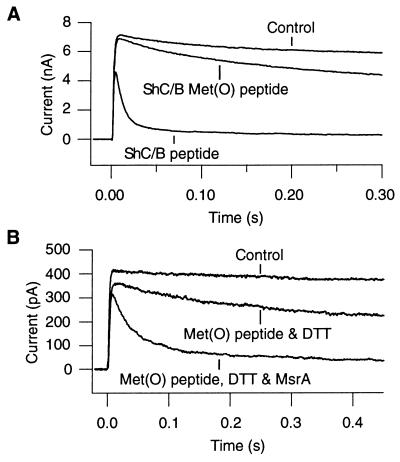Figure 5.
(A) The synthetic wild-type ShC/B peptide induces inactivation whereas the Met(O)-containing ShC/B peptide is much less effective. The ShBΔ6–46:T449V macroscopic currents at 0 mV were recorded in the inside-out configuration. Intracellular application of the wild-type ShC/B peptide (200 μM) rapidly induced inactivation whereas the Met(O)-containing ShC/B peptide (200 μM) was much less effective. The ShC/B peptide (Met-Glu-Met-ILe-Leu-Val-Ala-Gly-Gly-Ser-Leu-Pro-Lys-Leu-Ser-Ser) and the Met(O)-containing ShC/B peptide [Met-Glu-Met(O)-ILe-Leu-Val-Ala-Gly-Gly-Ser-Leu-Pro-Lys-Leu-Ser-Ser] were obtained from Genemed Biotechnologies, South San Francisco, CA (>85% pure). (B) Preincubation of the Met(O)-containing ShC/B peptide with MsrA and DTT (1 mM) restores its ability to induce inactivation. The ShBΔ6–46:T449V macroscopic currents were recorded as in A. The Met(O)-containing peptide incubated with DTT (1 mM) but not with MsrA is not markedly effective in inducing inactivation (125 μM). The Met(O)-containing ShC/B peptide (125 μM) was incubated with purified recombinant MsrA (0.03 μg/μl) (10) in the presence of DTT (1 mM) for 1.5 h at 37°C and applied to the patch.

